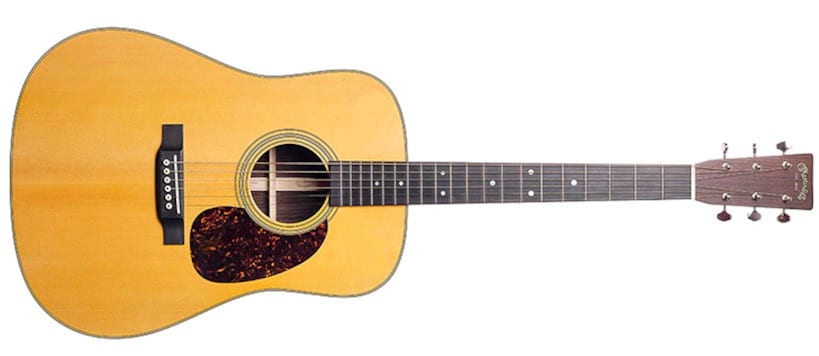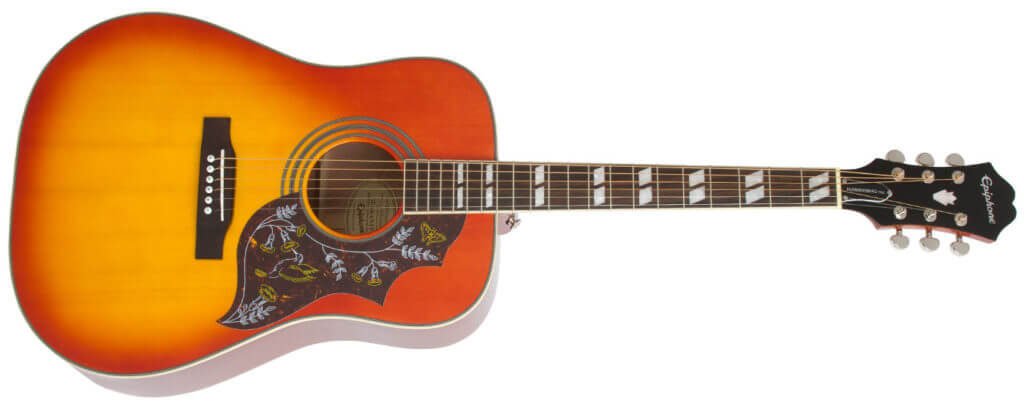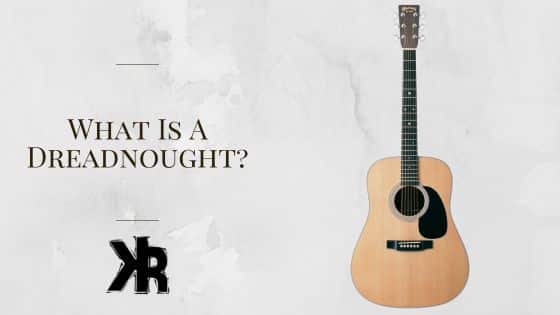Table of Contents
The dreadnought is a standout in the world of acoustic guitars. With its larger body, bold tones, and a name reminiscent of powerful battleships, it has earned a place in music history.
Created by the American guitar manufacturer C.F. Martin & Company, the dreadnought is known for its clear sound and strong volume. What makes the dreadnought different from other acoustic guitars? And why is it so popular among musicians?
This Killer Rig article will explore the history, features, and importance of the dreadnought guitar.
What is a Dreadnought Guitar?
A dreadnought is a type of acoustic guitar known for its large body shape, rich sound, and versatility in playing various music genres. The term is now used by most guitar companies to classify this body size.
The dreadnought is the most popular guitar body style, thanks to its massive projection and excellent tonal balance. These characteristics are brought forth by the larger resonance chamber and body proportions.
It’s interesting because the guitar was considered a failure and too large when it first released. It took people a few years to really understand the musical opportunity that was now readily available.
If you have never played a Dreadnought, you will be pleased to hear that it doesn’t take long before it feels natural. When I first got started playing guitar, it was on a Dreadnought, and it only took a few sessions before I was comfortable using it.
Now, this might not be the case for everyone, but the volume and bold sound it produces will entice you to at least give it a try!
Pros
- Loud and powerful sound due to its large and broad body.
- Great for playing rock, country, blues, and bluegrass.
- Capable of competing with an electric band without any additional support.
- The bold and full tone makes it great for both strumming and finger style playing.
Cons
- Can be uncomfortable to hold and play due to its size and weight.
- May not be suitable for younger or smaller guitar players due to its size.
- May not be ideal for those who prefer a guitar with less low end.
Origin and Development

The story of the dreadnought begins with the renowned American guitar manufacturer, C.F. Martin & Company. Established in 1833, Martin had a long-standing reputation for crafting high-quality instruments.
However, it was in 1916 that they introduced a design that would revolutionize the world of acoustic guitars: the dreadnought.
Named after the large, powerful battleships of the early 20th century, the dreadnought guitar was initially produced for the Oliver Ditson Company.
This design was characterized by its larger body, which was broader and deeper than most guitars of that era. The increased size allowed for a more robust sound, making it particularly suited for vocal accompaniment.
By the 1930s, the dreadnought’s popularity began to rise. Martin started producing these guitars under their own brand, leading to the creation of iconic models like the D-18 and D-28.
These models, with their clear tones and strong volume, quickly became favorites among musicians, especially in the realms of folk and country music.
Over the years, the dreadnought design underwent refinements, but its core characteristics remained.
Its influence spread far and wide, with other guitar manufacturers adopting and adapting the dreadnought shape, cementing its place as a staple in the acoustic world.
Design and Characteristics
The dreadnought guitar is easily recognizable by its specific design elements, which contribute to its sound. Here’s a closer look at its features:
- Body Size: One of the most defining traits of the dreadnought is its larger body. Compared to other acoustic guitars, it has a broader waist and a deeper body. This increased size allows for more air to resonate within the guitar, producing a louder and fuller sound.
- Shoulders and Bottom: The dreadnought features square shoulders and a flat bottom, as opposed to the more rounded shapes seen in other guitar designs. This shape contributes to its tone, emphasizing the bass and mid-range frequencies.
- Neck Attachment: Traditionally, the neck of a dreadnought guitar attaches to the body at the fourteenth fret. This positioning provides easier access to higher notes, making it versatile for both rhythm and lead playing.
- Soundboard: The top or soundboard of the dreadnought is typically made of spruce, a wood known for its clarity and dynamic range. The choice of wood, combined with the guitar’s size, results in a sound that’s both clear and resonant.
- Bracing Pattern: The internal bracing of the dreadnought is designed to support its larger top while also optimizing resonance. The X-bracing pattern, commonly used, helps distribute the vibrations evenly across the soundboard.
The combination of these design elements gives the dreadnought its characteristic sound, which is both powerful and nuanced.
What is a Dreadnought Used For?
The dreadnought guitar primarily supports genres requiring a pronounced acoustic presence. Its loud, bold, and bass-rich sound makes it a favorite in country, rock, jazz, and folk music.
The design of the dreadnought is particularly tailored for strumming and flat-picking, allowing musicians to project a clear and commanding sound, especially in group settings or live performances.
Suitability for Players:
- Beginners: The dreadnought’s robust sound and versatility make it a popular choice for beginners. Its forgiving nature in terms of sound projection can be encouraging for those just starting out.
- Professional Players: Seasoned musicians often favor the dreadnought for its consistent sound output and versatility. Its balanced range ensures it holds its own, making it a reliable choice for studio recordings and live performances.
Who Makes Dreadnought Guitars?
When it comes to dreadnought guitars, several brands have made their mark by offering instruments that combine quality craftsmanship, sound excellence, and aesthetic appeal. Here’s a look at some of the top brands known for their exceptional dreadnought guitars:
Martin
- Overview: C.F. Martin & Company, often simply referred to as Martin, is the pioneer of the dreadnought design. Established in 1833, this American brand has a rich history and is synonymous with high-quality acoustic guitars.
- Notable Model: The Martin D-28 is one of the most iconic dreadnoughts, loved for its rich tones and impeccable craftsmanship.
Taylor
- Overview: Taylor Guitars, founded in 1974, is known for its innovative designs and commitment to sustainability. Their dreadnoughts are praised for their clarity and balanced sound.
- Notable Model: The Taylor 210ce offers a modern take on the dreadnought design, with added electronics for amplified play.
Gibson
- Overview: Another heavyweight in the guitar world, Gibson has been crafting instruments since 1902. Their dreadnoughts are known for their warm tones and vintage appeal.
- Notable Model: The Gibson Hummingbird stands out with its artwork and rich, mellow sound.
Yamaha
- Overview: Yamaha, while being a diverse manufacturer, has a solid reputation in the guitar industry. Their dreadnoughts are often recommended for beginners due to their affordability and consistent quality.
- Notable Model: The Yamaha FG830 is a budget-friendly option that doesn’t compromise on sound or build quality.
Fender
- Overview: Primarily known for electric guitars, Fender also offers a range of acoustic instruments, including dreadnoughts. They combine traditional craftsmanship with modern features.
- Notable Model: The Fender CD-60S is a versatile dreadnought, suitable for players of all levels.
Price Ranges
Dreadnought guitars are available at various price points. From affordable entry-level models to high-end, boutique instruments. It’s important to establish your budget before looking into the many options.
Keep in mind that while more expensive guitars often boast better materials and craftsmanship, there are many quality dreadnoughts available at more accessible price points. Here are a few examples of prices:
| Model | Price |
|---|---|
| Martin D-28 | $3199.00 |
| Epiphone Hummingbird Studio | $450.00 |
| Taylor Academy 10 | $699.00 |
| Yamaha FGX5 | $1599.00 |
As you can see, there are many price points. From some of the best beginner acoustic guitars to more premium options.
Dreadnought Guitar Recommendations
So now that you know what a dreadnought is and the intricacies of the design, you’re probably wondering which are the best guitars on the market. Well, here are some of my favorites that I have come to love over the years.
Fender CD-60S

The Fender CD-60S is a testament to Fender’s commitment to quality and affordability. As part of Fender’s Classic
Design series, this dreadnought guitar is designed to cater to both beginners and more experienced players looking for a reliable acoustic instrument. Here’s a closer look at its features and what makes it stand out:
Design and Build
- Body: Crafted with a solid spruce top, the CD-60S offers a resonant and clear sound. The back and sides, made of mahogany, add warmth to the tonal quality, making it suitable for a variety of musical genres.
- Neck: The guitar features a comfortable ‘Easy-to-Play’ neck shape with rolled fingerboard edges. This design ensures smooth playability, especially for those longer jam sessions.
- Finish: Available in multiple finishes, including Natural, Sunburst, and Black, the CD-60S boasts a look that’s both classic and versatile.
Sound Profile
The combination of spruce and mahogany gives the CD-60S a balanced sound profile. It produces clear highs, defined mids, and a robust low end. Whether you’re strumming chords or picking out melodies, this guitar responds with clarity and depth.
Playability
One of the standout features of the CD-60S is its playability. The neck, with its smooth finish and ergonomic design, is accommodating for players of all hand sizes. The guitar’s action is set to be comfortable for beginners, reducing finger fatigue.
Taylor 210ce

The Taylor 214ce features a solid Sitka spruce top and layered Indian rosewood back and sides. The use of Sitka spruce for the top provides a broad dynamic range and enables the guitar to accommodate various playing styles, from fingerpicking to strumming.
The layered rosewood back and sides not only add to the guitar’s aesthetic appeal, but also contribute to its rich, full-bodied tone.
The guitar’s dreadnought body shape is known for its versatility. It’s designed to deliver a balanced output across the sonic spectrum, making it suitable for both strumming and fingerstyle playing.
The cutaway design allows easy access to the upper frets, making it a great choice for solo performers.
This guitar also comes with a pickup system called the ES2! The ES2 system captures the guitar’s dynamic properties and delivers a more natural amplified sound, making the 214ce an excellent choice for live performances.

Guitar Players that use the Dreadnought
The dreadnought guitar has been a favorite of many iconic musicians throughout history. Each one leaves a cerain mark on the instrument. They also inspire countless others to pick up a dreadnought of their own.
- Johnny Cash: His deep baritone voice and storytelling prowess were perfectly complemented by his Martin D-35 dreadnought guitar. His fingerpicking style and signature boom-chicka rhythm became hallmarks of his sound.
- Neil Young: A prolific singer-songwriter. Young’s powerful and emotive performances were often accompanied by his Martin D-45 dreadnought. His guitar work, blending folk, rock, and country influences, helped to shape the sound of an entire generation.
- Emmylou Harris: With her crystal-clear voice and heartfelt songwriting, Harris has been a staple of the folk and country music scenes for decades. Her trusty Gibson J-200 dreadnought has been by her side throughout her storied career, providing the perfect accompaniment to her captivating performances.
- Ed Sheeran: A modern pop sensation! Sheeran’s percussive guitar playing and soulful vocals have earned him legions of fans around the world. His signature Martin LX1E dreadnought guitar packs a punch and has become an integral part of his sound.
Conclusion
The dreadnought guitar has carved its place in the hearts of musicians and music lovers alike. Standing as a testament to innovation, craftsmanship, and versatility.
With its rich history, design, and impressive sound, the dreadnought has left a mark on the world of music, transcending genres, and generations.
Whether you’ve been playing for a while or are new to the world of guitar, the dreadnought offers a wealth of possibilities for creative expression and connection.
FAQs
Are dreadnought guitars good for beginners?
Yes, dreadnought guitars can be an excellent choice for beginners. Their body size provides a powerful and well-balanced sound that can be encouraging and inspiring for new players.
Additionally, many affordable dreadnought models are available on the market, making them accessible for those just starting their musical journey.
However, some beginners might find the size less comfortable. So it’s crucial to try different guitars and find the one that feels best in your hands.
Is it harder to play a dreadnought?
Playing a dreadnought for most people can be very comfortable. But not every dreadnought is the exact same size. Some of them are larger than others, which, for smaller people, can make them more difficult to play.
This doesn’t mean a smaller person will have trouble with a dreadnought. It just means that finding the right fit is more important.

